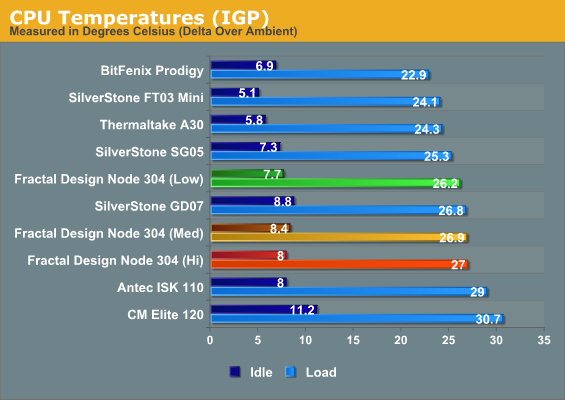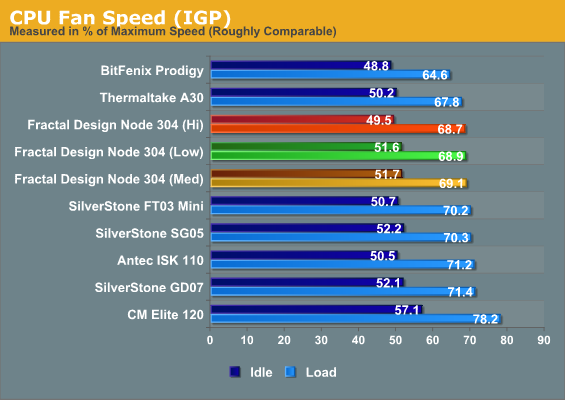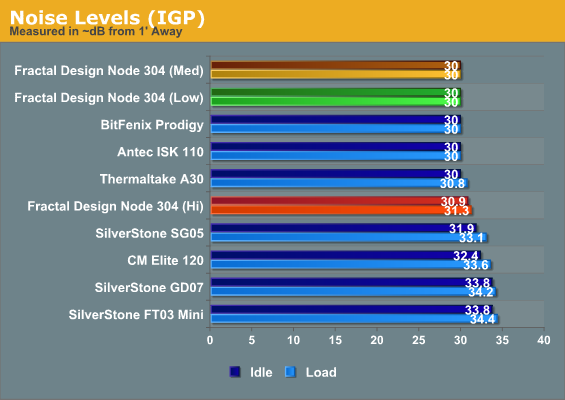Fractal Design Node 304 mITX Case Review: Paving the Way to the Future
by Dustin Sklavos on November 23, 2012 12:01 AM EST- Posted in
- Cases/Cooling/PSUs
- Mini ITX
- Fractal Design
- mITX
Noise and Thermal Testing, IGP
Admittedly, clearing out two of the drive brackets probably helped testing a great deal, but interestingly I'm not sure our stock testbed is actually very ideal for the Fractal Design Node 304. The reason is the way the motherboard is essentially stuck in a bit of a valley between the intake fans and the exhaust, hiding behind the power supply. A tower cooler would probably work gangbusters in this enclosure, but you'll see that even with the suboptimal downdraft cooler we still had reasonable performance.
The Node 304 was tested at all three fan control settings, and with winter setting in, ambient temperatures hovered between 23C and 24C.


You can see thermals are essentially competitive without being mindblowing. I think a tower cooler would make a big difference in this case, but as it stands the Node 304 isn't bad. Note that the higher fan speeds don't really add anything to the performance.

And, same as before, the different fan speeds don't produce any appreciable difference in performance. There's just no reason to run it at higher than the lowest fan setting.

I think it's particularly important to point out that the Node 304 at its lowest fan setting is basically inaudible at idle. Our sound meter doesn't dip low enough to tease out the differences, but you can see now that there's really no reason to turn up the fans. Even under sustained load, the Node 304 is incredibly quiet, and that makes the middle-of-the-road thermals much more tolerable.










80 Comments
View All Comments
londiste - Friday, November 23, 2012 - link
Any customer can have a car painted any colour that he wants so long as it is black.- Henry Ford
:)
silveralien81 - Friday, November 23, 2012 - link
Don't care much for the case but the Heinlein reference was great.versesuvius - Friday, November 23, 2012 - link
The problem with computer systems has always been and is, the wires that come out of the them, resulting in the ugliest part of the room. As for the space a case occupies, as long as the case has the same footprint, the height is not a problem with ordinary cases as long as they do not move into full, ultra towers. It is simply foolish to limit the potential of a computer system by restricting the space inside the box that is going to take the same real state on the desktop or under it anyway. Just go with a decently normal case. At least it will cover some of the ugly wires and cables sticking out of the case.bobbozzo - Thursday, November 29, 2012 - link
This is designed to be a server; it might go on a shelf with limited vertical space.dealcorn - Friday, November 23, 2012 - link
The diversity of use cases makes it hard to please readers with a case like this. When the Xeon Atom S12XX motherboards are released a case like this could make an attractive headless server. With 5 WD Reds, a 65 watt power adapter is the correct power supply. What are you supposed to do with the big empty hole where the ATX power supply ain't?Mumrik - Friday, November 23, 2012 - link
Since it clearly is made to be able to serve as a file server or HTPC/media vault, I'd really have liked to see it tested with six 3½" drives, or five and a 2½" SSD.If I wasn't going to take advantage of the storage options, I'd probably be looking at other cases, and it would be very nice to see if it actually was able to do what it seems to indicate it can - run safely while stacked with storage.
heraldo25 - Friday, November 23, 2012 - link
Strange that card-readers are not standard on *any decent* case nowadays, all laptops have them, why not all desktops? Particularly now that it is getting more popular to drop the 3.5" external bay which before could be used to insert a card-reader. Also, notebook-size dvd-drives do not take up much space, should be a slot for that IMO.Metaluna - Friday, November 23, 2012 - link
My guess is there isn't much market for them. Photo and audio file transfers seem to be moving in the direction of cloud-syncing rather than transferring from physical media (it would be interesting to know what percentage of photos just go direct to Facebook without ever touching a hard drive, for example. I bet it's pretty significant). And in a pinch you can just use your phone/camera/whatever as a reader anyway, which, though usually slow, is probably good enough for most people.Slim ODDs are kind of a mixed bag, IMHO, and not really worth the effort on a desktop machine. Not a lot of choices for Blu-ray, for example, and drive speed is usually lower than a full-sized drive. Plus the little mini connector is goofy and almost always requires adapters with ugly Molex connectors and so forth.
Grok42 - Friday, November 23, 2012 - link
The only think I've ever seen anyone use a card reader for is for a camera. Most people use their phone to take pictures and in case you haven't noticed, SD slots pretty much don't exist on modern phones. What else uses SD cards? Guess I've been a tech junkie for 20 years and never had the need to use an SD card other in my parents camera. They found it easier to transfer via USB rather than fiddle with using the SD card reader in their laptop. That said, I do find it odd that given how cheap they are that some case hasn't thrown in a built-in one, especially on the more expensive cases. Unlike 3.5" and 5.25" external bays which are deal breakers for me, I wouldn't have any problem buying a case with a card reader built-in even though I would never use it.Optical is dead as 8-track tapes. Should be easy to Velcro an external slim drive to the top of the case if you really want one always with the computer.
danjw - Friday, November 23, 2012 - link
2x 92mm and 1x 120mm, they call that ventilation? Just not going to do it will a modern graphics card, especially a dual GPU one.